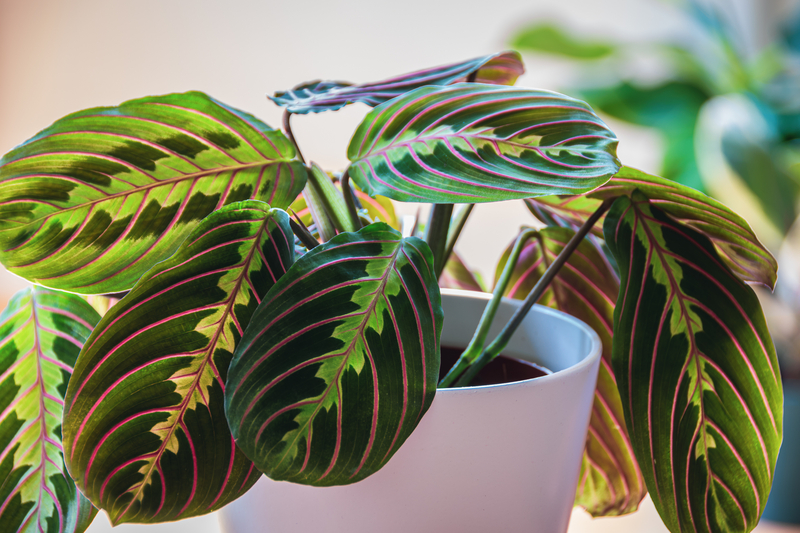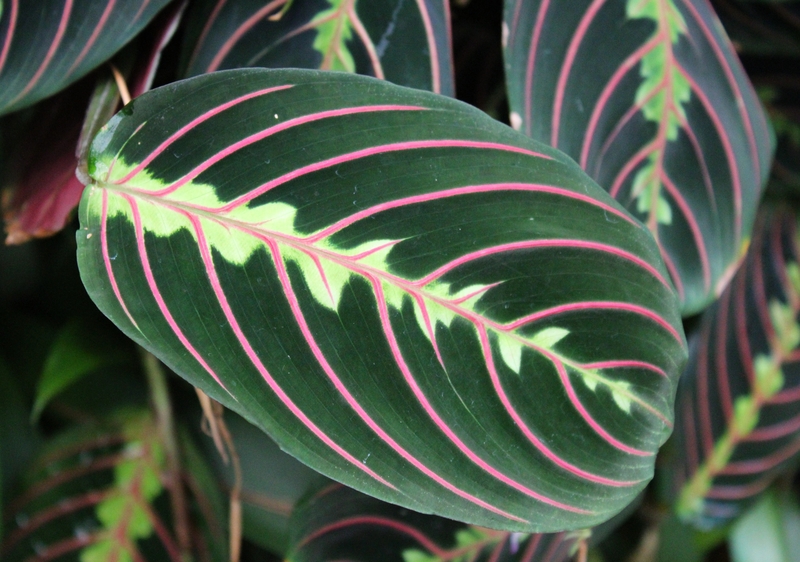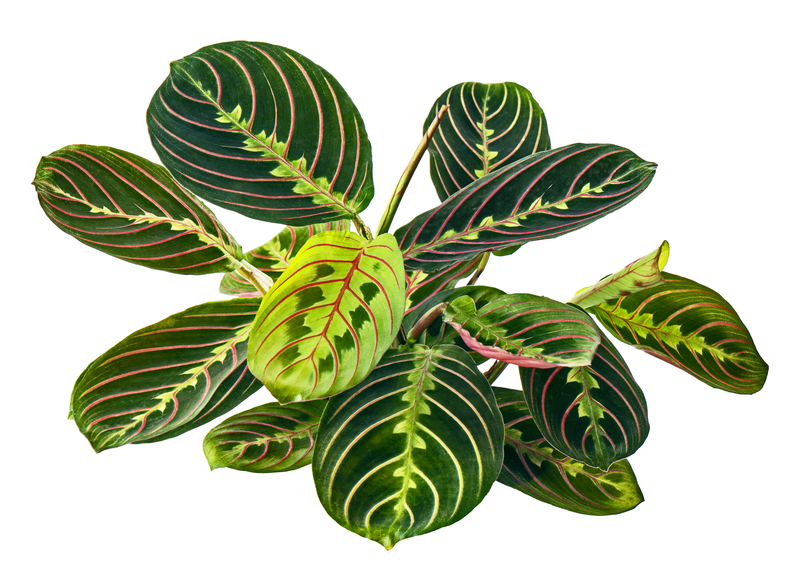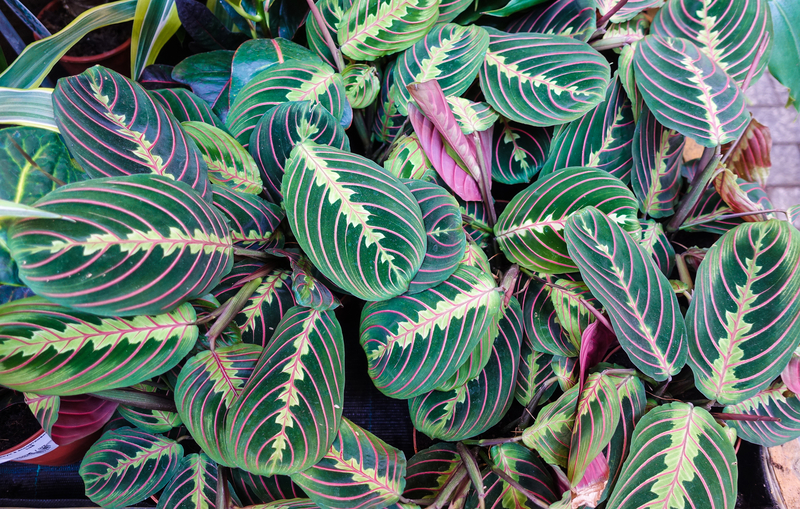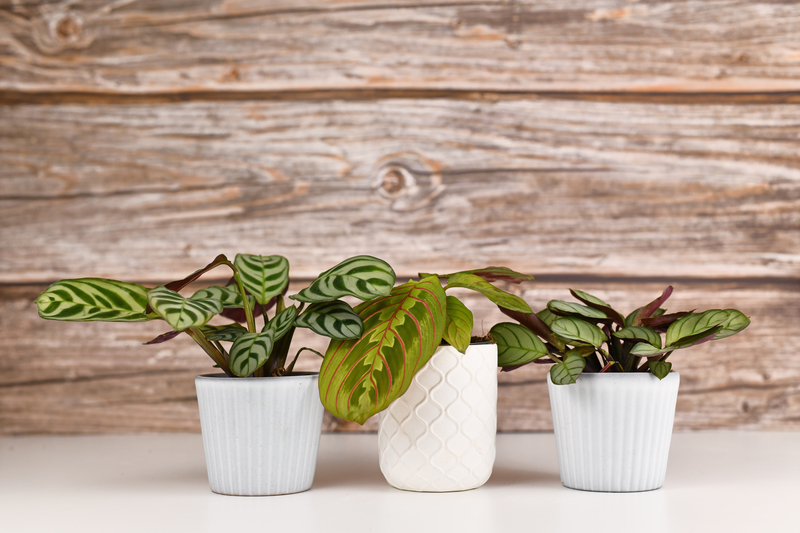The prayer plant is a tropical plant native to the rainforests of Brazil with bold green leaves, bright red veins, and yellow spots. It is part of the Marantaceae family, a group of related plants named after an Italian physician and botanist, Bartolomeo Maranta. Specifically, the prayer plant gets its common name from its unique leaves that lay flat during the day and curl up (like hands praying) at night.
A few prayer plants have slightly different colorings, but the tricolor variety is the most popular. They can bring a lot of color and interest to your home or office. Keep reading to learn everything you need to know about prayer plant care.
Other Names
- Maranta leuconeura
- Maranta leuconeura kerchoveana
- Herringbone plant
- Red prayer plant
What Soil Works Best for Prayer Plants?
Prayer plants do best with soil pH ranging from neutral to slightly acidic. The soil pH should range between 5.5 and 6. They will do well when potted with most standard, well-draining potting soil mixes. Also, you can add a little peat moss and coarse sand to your soil mix for this plant.
How Much Sun Does a Prayer Plant Need?
The prayer plant grows naturally in the lower parts of the rainforest. Therefore, it prefers partial shade or indirect sunlight. They are tolerant of low-light conditions.
It is better to trend on the side of lower light, as too much direct sun can wash out the colors of the leaves, burn the leaves, and create brown leaf spots or burnt leaf tips. Ensure your plant gets enough light but avoid placing your prayer plant directly in front of a bright, sunny window.
What Temperature Works Best for Prayer Plants?
Prayer plants do best with temperatures ranging between 60 and 80 degrees Fahrenheit. They do well at room temperature and in most temperature-controlled homes. Temperatures that are too cool can make the prayer plant susceptible to leaf loss and fungal infections. Be careful about leaving this plant near an AC unit in your home, as that temperature can cause the plant to wilt.
Do Prayer Plants Enjoy Humidity?
Since prayer plants come from the humid environment of the rainforest, they do well with high humidity. Low humidity can make the prayer plant susceptible to yellow leaves, leaf loss, and fungal infections. Consider placing your prayer plant in a bathroom that has a shower. You can also set a humidifier next to the plant to create extra humidity.
How Often Should You Water a Prayer Plant?
Prayer plants need frequent watering. They do best with moist soil and a pot with suitable drainage holes. The top layer of soil should be kept moist but not wet at all times. Don’t let the soil dry between waterings but also do not allow the plant to sit in standing water.
If you don’t water the plant often, the leaves may develop blotches, turn brown, or fall off. However, be careful about overwatering the plant, as the leaves may turn blotchy, yellow or brown, and fall off.
What Size Do Prayer Plants Grow to Typically?
Prayer plants are smaller plants that only grow to be about 6–12 inches tall and 6–12 inches wide when mature. They grow very slowly. They may only put out a couple of new growth leaves during the spring and summer growing seasons.
Most Common Bugs
Spider mites and mealybugs are two common pests to look out for on your prayer plant. The beautiful prayer plant leaves make for tasty food for the bugs, so regularly check the leaves for signs of infestation in your plant.
Spider mites are tiny black bugs that leave behind thin white webbing on the stems and leaves of your plant. They may also cause small brown spots on the leaves. Mealybugs leave behind a white, powdery substance on the leaves.
If you detect signs of any pests on your plants, spray your plant with neem oil or wash the leaves with insecticidal soap. You can also get rid of mealybugs with a cotton swab soaked in rubbing alcohol.
Most Common Diseases
The leaves are susceptible to tip burn, yellowing, and leaf spots. These issues are due to too much sunlight, overwatering, or underwatering. If your plant leaves look ill, try adjusting your prayer plant care routine.
Overwatering can cause the plant’s roots to rot. Interestingly, underwatering can also lead to a type of root rot caused by a fungus. Ensure the plant gets indirect light, and the soil remains moist but not wet. Finally, avoid getting water on the leaves since that can cause fungal issues.
How Often Should You Repot Prayer Plants?
Since prayer plants are slow growers, they do not need repotting very often. However, if you notice that your prayer plant becomes root bound, it may need to be divided and repotted. The best time to repot your Herringbone plant is in early spring.
How Do You Propagate Prayer Plants?
There are multiple ways to propagate a prayer plant, including from a stem cutting, from seed, and propagation by root division (also called slip division).
When taking a stem cutting, use clean, sharp scissors to cut a stem below a leaf node. Place the stem cutting in a clean glass of water for a couple of weeks until new roots begin to grow. Once there are roots, place the cutting upright in a small pot with potting mix.
If your plant is flowering, you can take the fun challenge of propagating from seed. Collect some seeds and keep them in a warm, moist bag until they sprout. If you divide the roots, split the plant, untangle the roots, and pot the roots in a new pot.
What is the Hardiness Zone for a Maranta leuconeura?
The hardiness zone for a Maranta leuconeura is 11 and 12 USDA.
Conclusion — How to Take Care of a Prayer Plant
In summary, Herringbone plants can be a challenging indoor plant for a beginner gardener, but they make attractive additions to any home or office. Their small size and bold leaves make them great plants on a shelf or other small space needing a little spruce. Keep it out of direct sunlight, have the soil moist, and you should enjoy your prayer plant for years to come!

